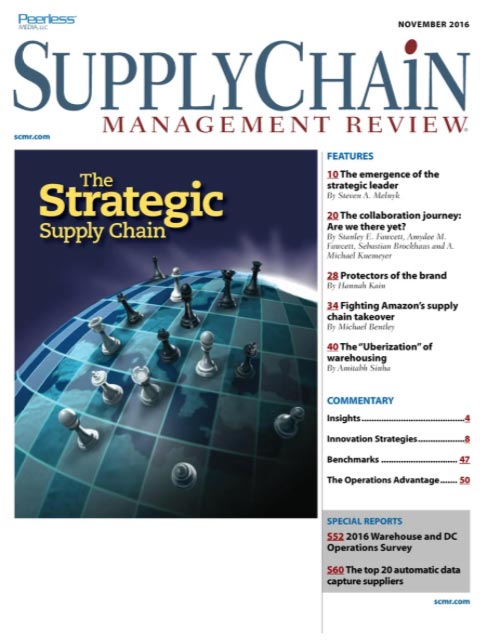Sorry, but your login has failed. Please recheck your login information and resubmit. If your subscription has expired, renew here.
November 2016
Is supply chain management strategic or tactical? Are the best supply chains collaborative? Should the goal be an integrated supply chain or an integrative supply chain? The answers are a mixed bag, according to this month’s contributors. Browse this issue archive.Need Help? Contact customer service 847-559-7581 More options
No doubt many of this journal’s readers already tap their mobile phones to get an Uber to the airport. Or they use the Airbnb app to find a nice place to stay for that long weekend. So it shouldn’t be a big surprise for them to learn that warehouse services can now be acquired in similar ways.
Dynamic warehousing is emerging as a viable way of purchasing warehousing services on demand—paying only for what is used instead of owning distribution centers or signing contracts with third-party logistics providers (3PLs).* As with Uber, Airbnb and a host of other shared-economy services, the actual pay-per-use transactions occur in an electronic marketplace. The approach can extend to a company’s entire warehousing strategy, or it may supplement an existing logistics network built on long-term contracts. In either case, it allows the company to adapt quickly to variable demand and cost conditions.
Dynamic warehousing can be particularly useful for e-commerce, where retailers typically face high demand uncertainty and often have significant capital constraints. Additionally, dynamic warehousing allows e-commerce retailers to rent small units of capacity in many parts of the country, enabling quick delivery to wider pools of customers.
This article introduces the idea and demonstrates its value with a brief case study.
 |
This complete article is available to subscribers
only. Click on Log In Now at the top of this article for full access. Or, Start your PLUS+ subscription for instant access. |
SC
MR
Sorry, but your login has failed. Please recheck your login information and resubmit. If your subscription has expired, renew here.
November 2016
Is supply chain management strategic or tactical? Are the best supply chains collaborative? Should the goal be an integrated supply chain or an integrative supply chain? The answers are a mixed bag, according to this… Browse this issue archive. Access your online digital edition. Download a PDF file of the November 2016 issue. |
Download Article PDF |
No doubt many of this journal's readers already tap their mobile phones to get an Uber to the airport. Or they use the Airbnb app to find a nice place to stay for that long weekend. So it shouldn't be a big surprise for them to learn that warehouse services can now be acquired in similar ways.
Dynamic warehousing is emerging as a viable way of purchasing warehousing services on demand—paying only for what is used instead of owning distribution centers or signing contracts with third-party logistics providers (3PLs).* As with Uber, Airbnb and a host of other shared-economy services, the actual pay-per-use transactions occur in an electronic marketplace. The approach can extend to a company's entire warehousing strategy, or it may supplement an existing logistics network built on long-term contracts. In either case, it allows the company to adapt quickly to variable demand and cost conditions.
Dynamic warehousing can be particularly useful for e-commerce, where retailers typically face high demand uncertainty and often have significant capital constraints. Additionally, dynamic warehousing allows e-commerce retailers to rent small units of capacity in many parts of the country, enabling quick delivery to wider pools of customers.
This article introduces the idea and demonstrates its value with a brief case study.
 |
SUBSCRIBERS: Click here to download PDF of the full article. |
SC
MR

Latest Supply Chain News
- Technology’s role in mending supply chain fragility after recent disruptions
- Tech investments bring revenue increases, survey finds
- Survey reveals strategies for addressing supply chain, logistics labor shortages
- Israel, Ukraine aid package to increase pressure on aerospace and defense supply chains
- How CPG brands can deliver on supplier diversity promises
- More News
Latest Podcast

 Explore
Explore
Latest Supply Chain News
- Technology’s role in mending supply chain fragility after recent disruptions
- Tech investments bring revenue increases, survey finds
- Survey reveals strategies for addressing supply chain, logistics labor shortages
- Israel, Ukraine aid package to increase pressure on aerospace and defense supply chains
- How CPG brands can deliver on supplier diversity promises
- How S&OP provides the answer to in-demand products
- More latest news
Latest Resources

Subscribe

Supply Chain Management Review delivers the best industry content.

Editors’ Picks





